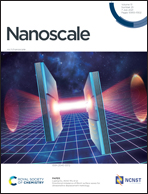Topographically designed hybrid nanostructures via nanotransfer printing and block copolymer self-assembly†
Abstract
Nanotransfer printing (nTP) has attracted much attention due to its high pattern resolution, simple process, and low processing cost for useful nanofabrication. Here, we introduce a thermally assisted nTP (T-nTP) process for the effective fabrication of various periodic three-dimensional (3D) nanosheets, such as concavo-convex lines, spine lines, square domes, and complex multi-line patterns. The T-nTP method allows continuous nanoscale 3D patterns with functionality to be transferred onto both rigid and flexible substrates by heat without any collapse of uniform convex nanostructures with nanochannels. We also show the pattern formation of multi-layered hybrid structures consisting of two or more materials by T-nTP. Furthermore, the formation of silicon oxide nanodots (0D) within a printed metallic nanowave structure (3D) can be achieved by the combined method of T-nTP and the self-assembly of poly(styrene-b-dimethylsiloxane) (PS-b-PDMS) block copolymers. Moreover, we demonstrate how to obtain well-defined oxide–metal hybrid nanostructures (0D-in-3D) through the spontaneous accommodation of PDMS spheres in the confined spaces of an Au-wave nanotemplate. This approach is applicable during the nanofabrication of various high-resolution devices with complex geometrical nanopatterns.



 Please wait while we load your content...
Please wait while we load your content...